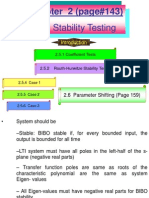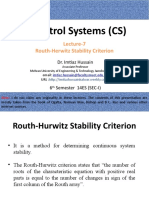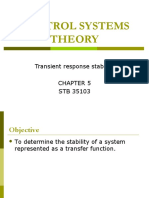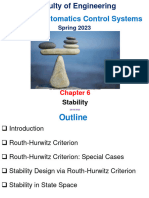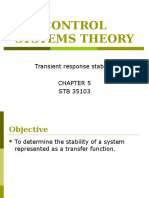0% found this document useful (0 votes)
7 views24 pagesChapter6 Spring 2024
Chapter 6 discusses the stability of systems, introducing the Routh-Hurwitz Criterion for analyzing the stability of linear time-invariant systems. It outlines various cases of stability, including stable, unstable, and marginally stable systems, along with examples demonstrating the application of the Routh-Hurwitz Criterion. The chapter emphasizes the importance of the characteristic equation and the Routh array in determining the stability of a system.
Uploaded by
ranajawadjoharCopyright
© © All Rights Reserved
We take content rights seriously. If you suspect this is your content, claim it here.
Available Formats
Download as PDF, TXT or read online on Scribd
0% found this document useful (0 votes)
7 views24 pagesChapter6 Spring 2024
Chapter 6 discusses the stability of systems, introducing the Routh-Hurwitz Criterion for analyzing the stability of linear time-invariant systems. It outlines various cases of stability, including stable, unstable, and marginally stable systems, along with examples demonstrating the application of the Routh-Hurwitz Criterion. The chapter emphasizes the importance of the characteristic equation and the Routh array in determining the stability of a system.
Uploaded by
ranajawadjoharCopyright
© © All Rights Reserved
We take content rights seriously. If you suspect this is your content, claim it here.
Available Formats
Download as PDF, TXT or read online on Scribd
/ 24












